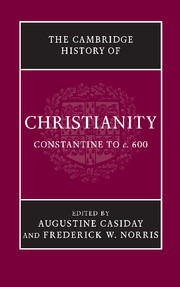Book contents
- Frontmatter
- Introduction
- Part I Christianity: Regional Developments
- Part II Christianity Contested
- Part III Christian Culture and Society
- Part IV Christian Beliefs and Practices
- 18 Discourse on the Trinity
- 19 History of Christology to the seventh century
- 20 Sin and salvation: Experiences and reflections
- 21 From Antioch to Arles: Lay devotion in context
- 22 Saints and holy men
- 23 Pastoral care and discipline
- 24 Sexuality, marriage and the family
- 25 The growth of liturgy and the church year
- 26 Interpreting scripture
- 27 Asceticism and monasticism, I: Eastern
- 28 Asceticism and monasticism, II: Western
- 29 Art and Propaganda fide: Christian art and architecture, 300–600
- Index
- Map 1 The Roman empire, c. 400">
- References
24 - Sexuality, marriage and the family
from Part IV - Christian Beliefs and Practices
Published online by Cambridge University Press: 28 March 2008
- Frontmatter
- Introduction
- Part I Christianity: Regional Developments
- Part II Christianity Contested
- Part III Christian Culture and Society
- Part IV Christian Beliefs and Practices
- 18 Discourse on the Trinity
- 19 History of Christology to the seventh century
- 20 Sin and salvation: Experiences and reflections
- 21 From Antioch to Arles: Lay devotion in context
- 22 Saints and holy men
- 23 Pastoral care and discipline
- 24 Sexuality, marriage and the family
- 25 The growth of liturgy and the church year
- 26 Interpreting scripture
- 27 Asceticism and monasticism, I: Eastern
- 28 Asceticism and monasticism, II: Western
- 29 Art and Propaganda fide: Christian art and architecture, 300–600
- Index
- Map 1 The Roman empire, c. 400">
- References
Summary
The years under consideration in this volume witnessed the remarkable transformation of Christianity from a persecuted minority sect into the dominant political and cultural force in the Mediterranean world. One aspect of this development was the formation of a set of discourses and practices regarding sexual, marital and familial life. The extension of ecclesiastical (and, to a lesser extent, imperial) authority into areas of human life previously regarded as private produced what has been called a ‘totalising discourse’, one that assisted Christianity in establishing its influence in early medieval and Byzantine society. This new cultural activity manifested itself in many ways, most notably in the laws of emperors, bishops and church councils, in liturgical practice, and, above all, in preaching and theological discourse.
Civil and ecclesiastical legislation
Christianity arose at a time when the Roman empire itself had begun to stress the importance of legitimate marriage and childbearing for the maintenance of social and political life. The emperor Augustus issued several laws that imposed inheritance restrictions on men and women who remained unmarried or who failed to produce children in marriage; conversely, those who married and had children were accorded certain social and economic privileges (Lex Julia de maritandis ordinibus, 18 bc; Lex Papia-Poppaea, 9 ad). While such legislation affected only a small percentage of the population, it reflected the emperor’s desire to reinforce the institution of marriage and legitimate childbirth. The Augustan legislation also made adultery (defined as sexual relations by a married woman with a man other than her husband) a public crime, rather than a private, family matter.
- Type
- Chapter
- Information
- The Cambridge History of Christianity , pp. 585 - 600Publisher: Cambridge University PressPrint publication year: 2007
References
- 3
- Cited by

